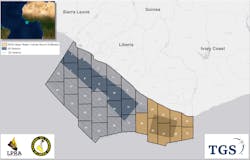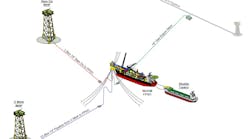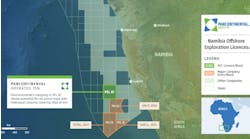NORTH AMERICA
DNV GL will oversee design review activities for Bay du Nord, Equinor’s first oilfield development offshore Newfoundland and Labrador. The location is in the Flemish Pass basin, 480 km (298 mi) northeast of St John’s, with an investment decision planned for summer 2021. Current plans call for an FSPO with a disconnectable turret mooring system and four subsea wells connected to subsea templates. Equinor aims for start-up in 2025.
◆◆◆
Late last year Pemex was preparing to start commercial operations at its new Abkatun-2 platform in the Bay of Campeche offshore Mexico. McDermott’s built the structure – the largest project to date for the yard in Altamira – to provide expansion/replacement capabilities for the offshore Ku-Maloob-Zaap, Cantarell and Ayatsil field facilities.
CARIBBEAN SEA/SOUTH AMERICA
BP has discovered a new gas field 80 km (50 mi) offshore Trinidad’s southeast coast. The Ginger exploration well, designed to test two fault blocks east of the Cashima field in water depths of less than 91 m (300 ft), found hydrocarbon-bearing reservoirs in 15 separate segments.
The company has since engaged Aker Solutions to perform front-end engineering and design (FEED) for a minimal facilities platform for the Cypre project offshore Trinidad and Tobago. This could be the first of a series of unmanned facilities for BP in the region.
◆◆◆
ExxonMobil has authorized SBM Offshore to start FEED work for a third FPSO for the Stabroek block offshore Guyana. The hull for the Payara oil development will be of SBM’s Fast4Ward design, similar to the FPSO Liza Unity currently under construction for the Liza Phase 2 project. Following installation, SBM will lease and operate the vessel, to be named Prosperity, for up to two years before transferring ownership and operation to ExxonMobil. The vessel, moored in a water depth of around 1,900 m (6,234 ft), will be capable of producing 220,000 b/d of oil with associated gas treatment capacity of 400 MMcf/d. Saipem will have EPCI responsibilities for around 130 km (81 mi) of flowlines, risers and umbilicals for Payara, repeating its role in Liza Phases 1 and 2.
◆◆◆
Tullow Oil and partners Total and Eco (Atlantic) Oil & Gas have agreed to enter the next phase of exploration on the Orinduik block, close to Stabroek, following their heavy-oil Jethro and Joe discoveries in 2019. They will likely target further prospects in the Tertiary and deeper Cretaceous intervals.
◆◆◆
Petrobras was the sole major to lodge bids as operator for Brazil’s Transfer of Rights Agreement bid round in the presalt Santos basin late last year. The company secured a 90% operated interest in ‘surplus volumes’ in the giant deepwater Búzios field, in partnership with CNODC Brasil and CNOOC Petroleum Brasil (5% each). In addition, Petrobras was awarded full rights to the Itapu field’s surplus volumes in the same region. To date the company has installed four FPSOs on Búzios which collectively produce 600,000 boe/d, with a fifth floater set to join them in 2022.
Colombia’s Ecopetrol has agreed to farm into 30% of the BM-S-54 concession and the Sul de Gato do Mato production-sharing agreement, both in the presalt Santos basin and including the Gato do Mato oil discovery. Operator Shell would reduce its present stake to 50%. Three wells drilled to date on the blocks have encountered light hydrocarbons.
WEST AFRICA
BP has discovered another potential gas giant offshore Mauritania. The Orca-1 well, drilled 125 km (77.7 mi) from the coast in 2,510 m (8,235 m) of water, targeted a previously untested Albian play. Results, according to partner Kosmos Energy, exceeded expectations with the well delivering 36 m (118 ft) of gas pay in good-quality reservoirs. It also extended the Cenomanian play fairway, intersecting 11 m (36 ft) of net gas pay in a down-structure position relative to the Marsouin-1 discovery. Kosmos estimated in-place reserves at 13 tcf.
The same partners have contracted McDermott International to fabricate the subsea production system and to manage the SURF scope for the Greater Tortue Ahmeyim project off Mauritania and Senegal at the company’s Batam yard in Indonesia.
◆◆◆
Woodside Energy has submitted the first-phase development plan for the deepwater Sangomar oil and gas field to Senegal’s government. The project, 100 km (62 mi) south of Dakar in the Sangomar Deep Offshore block, will eventually produce 485 MMbbl of oil and 160 MMboe of gas. Phase 1, targeting 230 MMbbl of oil, calls for a 100,000-b/d capacity FPSO with 23 subsea wells and is scheduled to come onstream in early 2023. The vessel will also be designed to accommodate extra facilities serving future phases, including gas export to shore and tiebacks from other reservoirs and fields. Sangomar, formerly known as SNE, was renamed after an island that is also part of the country’s Saloum Delta National Park.
◆◆◆
Senegal’s state oil company Petrosen planned to inaugurate the country’s first offshore licensing round at this month’s MSGBC Basin Summit & Exhibition. On offer are 10 blocks, mostly in ultra-deepwater, with the round remaining open until the end of July.
TGS, which is supporting the round with 2D and 3D seismic, multi-beam and seafloor sampling data from across the MSGBC basin, is doing a similar job for Liberia’s Petroleum Regulatory Authority, which is targeting an April launch for Liberia’s next offshore round. This covers nine blocks in the little-explored Harper basin. TGS has identified syn-rift structural traps over much of the area with analogues to producing fields in neighboring basins.
◆◆◆
Nigeria’s National Assembly has voted to replace the current water depth-based royalty with a uniform 10% royalty for all the country’s deepwater production-sharing contracts and to introduce a further royalty arrangement based on the oil price. According to consultant Wood Mackenzie, the measures could raise royalty payments on deepwater fields from the present 0-8% to 14%, hitting the industry with a loss of value of $2.7 billion over the assets’ remaining lifespans. Although the government might benefit in the short-term from higher revenues, the change could cause investors to switch capital to projects elsewhere offering better returns.
◆◆◆
Equatorial Guinea’s Ministry of Mines and Hydrocarbons has awarded offshore blocks to African, European and North American oil companies under the country’s EG RONDA 2019 bid round. Successful bidders included Lukoil, VAALCO Energy, and Nigeria’s WalterSmith. In addition, the Ministry signed a co-operation agreement with Vitol on the Gas Megahub project, which involves developing new offshore gas hubs to monetize presently stranded gas resources offshore Equatorial Guinea. The government also hopes to extend the network to fields off neighboring Nigeria and Cameroon.
◆◆◆
BW Energy has modified its Ruche development plan offshore Gabon to accommodate the recent Hibiscus oil discovery in the Dussafu license. Ruche Phase 1 production should now double from 15,000 to 30,000 b/d, with the planned wellhead platform moved 4 km (2.5 km) to the west to tie in production from Hibiscus, where four wells will be drilled in addition to the two Ruche wells. First oil is slated for late 2021; up to seven more wells could follow under Phase 2 in order to maintain plateau production. The estimated capex now stands at $445 million.
EASTERN EUROPE
First gas was due to flow early this month through the new Balticconnector pipeline between Finland and Estonia. Commissioning of the system finished in late November when the offshore section through the Baltic Sea, laid by Allseas, was filled with gas, pressurized and connected to Estonia’s gas transmission network. The system, which will be bi-directional, has a design capacity of 7.2 MMcm/d.
◆◆◆
Hungary’s MOL has agreed to pay Chevron $1.57 billion for its interests in the Azeri-Chirag-Gunashli (ACG) oilfield in the Caspian Sea offshore Azerbaijan and the Baku-Tbilisi-Ceyhan pipeline that transports the field’s crude to Ceyhan on the Turkish Black Sea coast. If regulatory consents come through for the deal, MOL will become the largest partner in the six-platform ACG complex, which produced 584,000 b/d in 2018.
MIDDLE EAST
The jackup Foresight Driller IX was due to spud an appraisal well last month for Masirah Oil on the Yumna oilfield in block 50 offshore Oman. The contract included options for extended well testing and further drilling. Wings Offshore in Singapore is converting the Aframax tanker Mt Bull Papua to store the produced crude.
◆◆◆
Late last year the first two jackets were loaded out for Qatar Petroleum’s North Field expansion project offshore Qatar. The company also revealed plans to further raise Qatar’s LNG production capacity, supplied by North Field gas, by 64% to 126 MMt/yr in 2027.
ASIA/PACIFIC
Singapore-based KrisEnergy has contracted PT Profab1 to construct a minimum facilities wellhead platform for the Apsara oilfield development in block A offshore Cambodia. The completed structures will be loaded onto a barge at Profab’s yard in Batam, Indonesia, for transportation to the field location in the Khmer basin. Apsara is due to start production during the first half of this year at an initial rate of 7,500 b/d.
◆◆◆
Vietnam’s government has approved Murphy Oil’s outline development plan for the Lac Da Vang oilfield in block 15-1/05 in the Cuu Long basin offshore southern Vietnam. FEED work is already under way.
◆◆◆
CNOOC has started production from its Caofeidian 11-1/11-6 oilfield comprehensive adjustment project in 20-25 m (65.6-82 ft) of water in China’s Bohai region. This involved connecting two new processing platforms to existing facilities at the Caofeidian oilfield. Twelve wells were onstream at start-up, and production should build to a peak of around 28,700 b/d in 2021.
◆◆◆
Premier Oil has produced first gas from the Bison, Iguana and Gajah Puteru (BIG-P) fields in the Natuna Sea block A offshore Indonesia. The company expects to recover more than the 93 bcf targeted in its original project plan following a successful three-well drilling campaign. All production heads through existing block A infrastructure for export to Singapore. •





